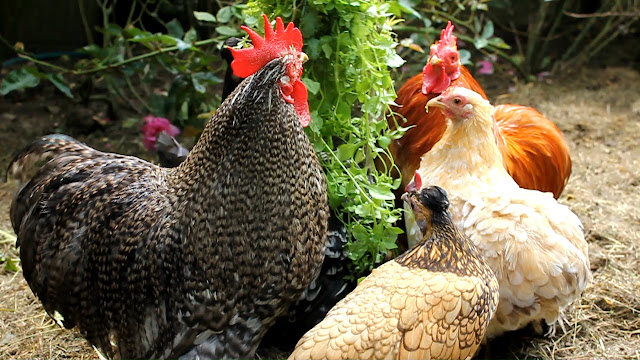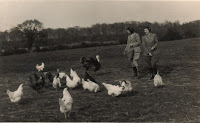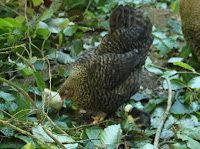This is probably one of my most crazy ideas to date. The premise being to gather together as many of our flock(s) as possible to fulfil the criteria for this variation on the old carol: The Twelve Days of Christmas. See film below.
Left is an illustration from the first appearance of the original song in print in the rather reprovingly entitled children's book: Mirth without Mischief published in 1780. A free downloadable copy of this text can be found at the Internet Archive (link at the end of this post).The song's popularity came to the fore much later in 1909 with lyrics and melody by the English composer Frederic Austin.
In my head it was quite easy to work out how to choose the different individuals for the film. All these birds live together in the forest garden but as they are attached to different coops and trees, each with their attendant dominant birds and when it came to collecting them up, I realised how easily this could turn into a Christmas recipe for disaster.
So, here are the basic ingredients:
12 Crazy Chick Chicks - ...and they were because chicks expect to be paid to perform but a potential food fight would have spoiled the aesthetic.
11 Fiery Frizzles - ironically they were actually the best behaved
10 Blue Hens and Cockerels - some alpha hens and cockerels in this group but again on their best behaviour - which is why it is always best to film this sort of project at night and postprandially.
9 Playful Polish - rather damp because I had been emptying and bagging up my compost bin and they'd been having a great time hunting for invertebrates and so I had to wash all crests.
8 Cuddly Cochins - actually the worst behaved, it took several takes to get them calm. 'Bouboule' the black Frizzled Cochin is four months shy of his tenth Birthday and he likes his own space, sharing it even for a few seconds with anyone (even his own grandchildren) is not his idea of fun.
7 Colourful Quailees - impeccable as always
6 Daffy Ducklings - of fond memory from my most viewed film
5 Golden Hens - Chickles (bottom left on the screen) was just spoiling for a fight and as these are all Sebright crosses this is not surprising.
4 Festive Fantails - one of our favourite fantail pictures that Andy originally entitled 'My Dad's bigger than your Dad' and which one year we sent out as a Christmas card.
3 French Hens - as they were all hatched in Normandie, I guess all my hens could be called that but these three have some of the chic-est plumage.
2 Little Sweethearts - aka Mischief Makers and...
A Silkie in a Pear Tree - our re-homed Silke, photoed in our pear tree - even if I'd wanted to, I couldn't have filmed him in a bare Winter pear tree because he'd been in the compost heap too and it would have taken more than a damp cloth to get him prepped for filming!
In between the filming of each segment, we had to take everyone back to their roosting places, albeit in coop or tree branch, and therefore this whole shoot took quite a while and we finished just before 4 am. It was such fun though and the chicks did get their payment post filming with a wrap party.
Hope you enjoyed the film and if you did, then think about going onto YouTube or Odysee or Bitchute (links below) and giving it a thumbs up.
Thanks for dropping by and do feel free to share experiences or ask for further information in the comment section. If you have enjoyed this piece and found it useful think about sharing it with your family and friends, on social media and also maybe about joining this blog and/or subscribing to my Youtube, Odysee or BitChute Channel or even supporting us on Patreon or
Until next time, all the very best from sunny Normandie!
© 2021 Sue Cross















